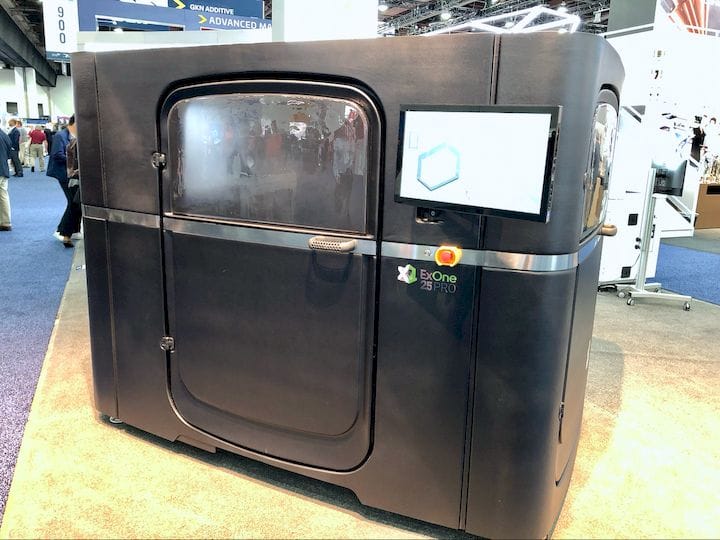![The ExOne X1 25 PRO metal 3D printer [Source: Fabbaloo]](https://fabbaloo.com/wp-content/uploads/2020/05/image-asset_img_5eb09514e43ab.jpg)
ExOne’s new X1 25PRO production 3D printer holds some surprises.
The Augsburg, Germany-based company has been producing sand 3D printers since the early 2000s and also has the capability of 3D printing metals and ceramics on their now-extensive line of equipment.
The metal 3D printing process used by ExOne is a little different from the usual powder-bed / laser approach used by most others. Instead they have a multi-step binder jetting process that uses powder. Here you can see how it works on one of their other machines:
Binder jets fix selected powder regions on a flat bed of powder, layer by layer. These raw parts are cured to make them more solid. Then after removal and cleaning, the parts are fired in a furnace where metal infiltrates into the object structure.
![3D printed handle on the ExOne X1 25PRO metal 3D printer [Source: Fabbaloo]](https://fabbaloo.com/wp-content/uploads/2020/05/image-asset_img_5eb095153f068.jpg)
Now the company offers the X1 25PRO device, that is an offshoot of their previous INNOVENT systems. These are small devices targeted at research organizations wishing to experiment developing metal powders. Now that same technology has been scaled up into a production-level device, the X1 25PRO.
It’s an interesting sequence that ExOne has devised here: first a company could iteratively develop a unique material on a small, relatively inexpensive INNOVENT machine. Then when perfected the same material can be easily 3D printed on the larger (400 x 250 x 250 mm build volume) X1 25PRO.
I should mention at this point that the X1 25PRO is designed to operate as a production device; it can run continuously for long periods and provides the necessary production interfaces for proper use.
The interesting feature of the X1 25PRO is that it can apparently handle standard MIM (metal injection molding) powders. This means it can produce objects in a wide variety of metals at relatively cheap costs, as MIM materials are priced as commodities. ExOne says they are able to achieve this due to their advanced compacting and spreading technology for their recoating system, which puts down layers of powder.
ExOne says that the machine has already been tested with several different materials:
“316L, 304 L, and 17-4PH stainless steels; Inconel 718® and 625; M2 and H11 tool steels; cobalt chrome; copper; tungsten carbide cobalt and many other alloys are 3D printable on the X1 25PRO.”
![Detail shot of the case surface on the ExOne X1 25PRO metal 3D printer [Source: Fabbaloo]](https://fabbaloo.com/wp-content/uploads/2020/05/image-asset_img_5eb09515923a1.jpg)
When we were examining the X1 25PRO we could not help but notice its unusual case, which is unlike any I’ve seen on a major production 3D printer. We asked ExOne about it and were told that it is vacuum formed on a 3D printed mold – something the company is quite expert at printing.
If you examine the case closely you can see the slight texture that originates with the 3D print. It’s a very unique look that makes the machine stand out among so many near-identical case stylings for competitive equipment.
![The ExOne X1 25PRO metal 3D printer [Source: Fabbaloo]](https://fabbaloo.com/wp-content/uploads/2020/05/exone-25pro-label-1_img_5eb09515e3c71.jpg)
ExOne says the X1 25PRO will sell for near US$600K and be available later this year. For now, they’ve lined up a number of beta testers at companies to test out the features, and they also have at least one production order already taken.
Via ExOne











FELIXprinters has released a new bioprinter, the FELIX BIOprinter, which is quite a change for the long-time 3D printer manufacturer.